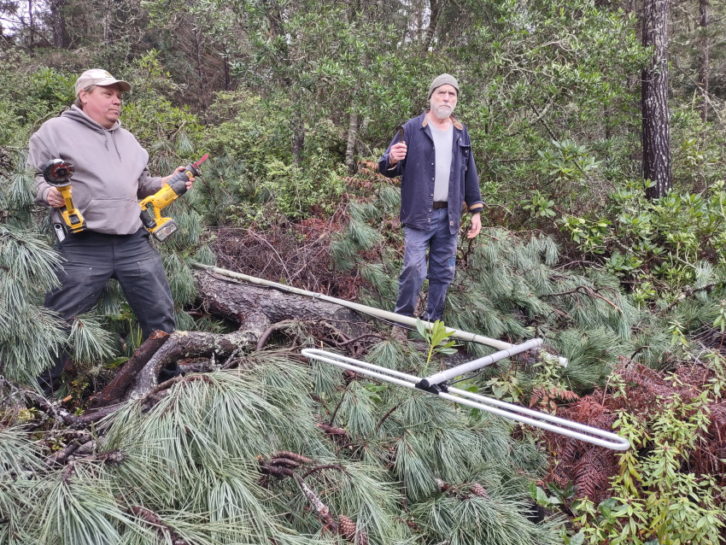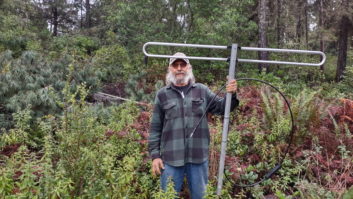A low-power FM radio station in northern California is still in recovery mode after a series of storms brought down its rather unusual tower: a 70-foot pine tree.
Throughout the month of January, a series of atmospheric rivers — monster storms that form over the ocean and flow inland — swept though the Golden Sate, causing billions of dollars in economic losses and property damage. KNYO(LP) in Fort Bragg, Calif. (pop. 6,970) was not immune.
On Jan. 4, the 70-foot tree that held up KNYO’s antenna was completely uprooted. After serving the station for 16 years, KNYO Station Manager Bob Young said the mighty pine was no longer.
“The tree had still been alive but apparently had some damaged areas, as a lot of the pine trees here have from drought and pine bark beetles,” Young told Radio World. “It served us well.”
The station’s still-functioning, omnidirectional Jampro antenna is now desperately in need of a new home.

KNYO is licensed to the Noyo Radio Project with an 87-watt signal on 107.7 MHz. Since its tree tower was brought down, KNYO has been working to raise $5,000 to fund the construction of a tower as well as antenna installation. As of Feb. 18, the all-volunteer station had received more than $4,000 in community donations and “will be making some hard decisions and doing some building soon,” according to Young on KNYO’s GoFundMe page.
To learn more about KNYO’s recovery efforts, as well as its unique antenna placement, Radio World asked Young a few questions via email. His responses are as follows:
Radio World: In regards to the tree-mounted antenna: Isn’t that arrangement unusual? How did you come to decide to do that?
Bob Young: Putting a broadcast antenna on a tree is, to my knowledge, pretty unusual. When it was initially discussed, local professional antenna installers were quick to point out that trees are largely water, and said that the surrounding canopy of 50- to 100-foot-tall trees, and the mast tree itself, would soak up a lot of RF and make it unusable. We also spoke to DIY ham radio folks who had some success using trees. Our lack of experience was probably a factor as we did not have many LPFMs up here in 2005 with whom we could communicate.
As dedicated DIY-ers out here in the woods, we considered it. Our fundraising efforts were not very successful in 2005, as we have several excellent FM stations here and interest in ours was slight. With the deadline of our 18-month construction permit approaching we had to make some hard decisions. We went the least expensive route. We purchased a Broadcast Warehouse TX-150, a Trilithic EasyPlus [EAS system], a relatively inexpensive Jampro JFWD folded FM dipole antenna (a great purchase, it is still in use, no damage when the tree fell) and the cheapest usable coax. [We were also] gifted a lightning arrestor system, an Optimod processor and a couple computers and some home audio gear and gear from a local band. A close friend and expert tree man climbed the 80-foot tree, topped it, and mounted our antenna at 70 feet.
The installation was amazing to me. High tree work is dangerous, but he finished in four hours, no big deal, and donated his services. We were on the air and getting our desired five-mile coverage! Our research at the time, at the FCC site and with the team then at Prometheus Radio Project could find no prohibition of trees. It is still legal I believe. We just had several professionals who strongly advised against it.

RW: You said an FCC inspector visited the tower site in 2006 and approved the build; what did he have to say about the unusual setup?
Young: It is also unusual for the FCC to do inspections out here. We have more FM stations here than in 2005, but [it’s] still a tiny market. Apparently some doofus was experimenting with a transmitter and was stepping on the police channels. While they were here the FCC agents visited every station up here. I got a call one day from my fellow board member and owner of the station site that there was an agent visiting. I was a letter carrier for the USPS and I received permission to leave my route and go talk. It was Agent Thomas Hora who is now retired. He looked at the antenna and said “Well, we don’t have to worry about tower violations.” He was very helpful, advised us to keep a handwritten copy of our EAS transmissions and approved of our setup.
RW: Would the growth of a tree not change the antenna’s actual height, thus putting KNYO out of compliance?
Young: Trees grow through meristematic growth of the shoot stems — the root stems — or lateral meristematic growth, which means that the tops grow upward, the roots grow downward and lateral growth expands the girth. If you place a nail in a tree at three feet height and return 30 years later, the tree may have absorbed the nail through lateral growth but it will still remain at three feet height. Our local tree experts taught me that.

We did experience a problem with lateral meristematic growth. The coax was fastened to the tree with large industrial cable ties. After about 12 years of trunk expansion all the cable ties popped!







